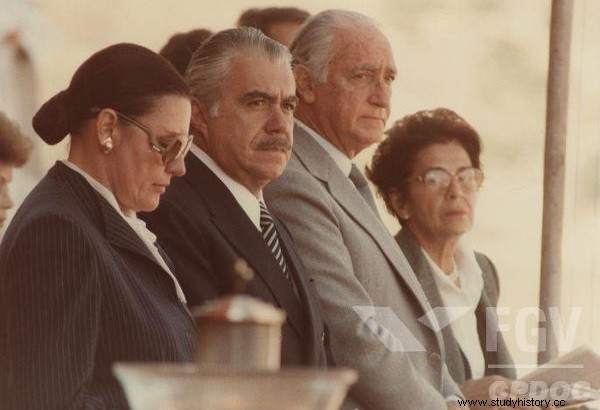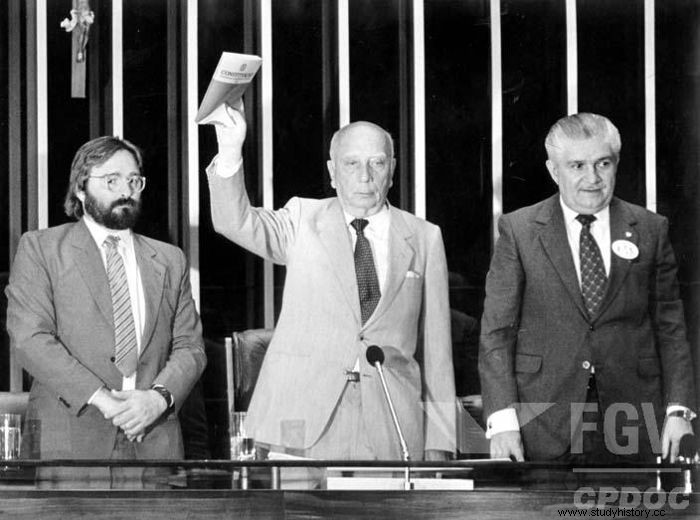The Sarney Government was marked by being the first civilian government to take over Brazil after 21 years of Dictatorship Military . José Sarney assumed the presidency after the tragic death of Tancredo Neves, the president-elect in 1985. Sarney was responsible for leading the country's return to democratic normality.
One of the great milestones of this government was the formation of a Constituent Assembly that drafted and promulgated the 1988 Constitution. José Sarney's government was also known for failing to fight the economic crisis that ravaged the country. The politician from Maranhão governed the country between 1985 and 1990.
Login also :FHC – the life of one of the great names of the New Republic
Redemocratization
In the late 1970s, the military chose to carry out the political transition in Brazil in order to carry out an opening of the regime to hand power back to civilians. Historians understand this action by the military not as an action in search of the democratization of the country, but rather an opening that would maintain civilian government, but linked to military interests.
The opening planned by the military ended up not working out because of the population's commitment to the democratization of the country . One of the popular movements symbolizing this struggle was the Movimento das Diretas Já , driven by the Dante de Oliveira Amendment , which debated about the return of direct elections in Brazil.
The Diretas have already mobilized millions of Brazilians in rallies held in all parts of the country. The population wanted to be able to choose the president of the country, after more than twenty years of the last time that right had been exercised. The amendment by Diretas Já, however, was defeated and the 1985 presidential election remained indirect .
For the 1985 election, the military decided to launch, through the Social Democratic Party (PDS), the party heir to Arena, the candidate Paulo Maluf . This decision displeased José Sarney, who wanted to hold primaries within the PDS and not a simple nomination. Sarney was the president of the PDS and ended up breaking with the party and moving to the PMDB.
The opposition to the military, formed mainly by the PMDB (Brazilian Democratic Mobilization Party), decided to mobilize to launch a candidate and run against Paulo Maluf. The candidate chosen by the PMDB was Tancredo Neves , traditional Minas Gerais politician, and, as his deputy, was chosen José Sarney .
There was intense political movement inside the Electoral College and Tancredo Neves managed to stand out from the candidate supported by the military, obtaining 480 votes against 180 votes obtained by Paulo Maluf. With this result, for the first time in 21 years, Brazil would have a civilian in the presidency. It was the end of the Military Dictatorship .
Death of Tancredo Neves

Tancredo Neves' presidential inauguration was scheduled to take place in March 15, 1985. In the weeks before taking office, Tancredo hid from everyone that he felt abdominal pain, because he feared that this could be used as a justification by the military to perpetuate itself in power. He planned to seek medical treatment after his inauguration, but on the eve of his inauguration, on March 13, he ended up being hastily admitted .
The handling of Tancredo's situation was very bad, since he was operated on in a hospital with questionable technical and hygienic conditions. He was transferred to São Paulo, undergoing seven surgeries, but end up dying on April 21, 1985. While he was hospitalized, the country wondered who would assume the presidency.
After much debate and much political negotiation, it was decided that the vice president would take over temporarily until Tancredo Neves recovers. Therefore, on March 15, José Sarney took office as interim president of Brazil. By an irony of fate, the presidency of Brazil after the dictatorship fell into the lap of a politician who built his career as a supporter of the dictatorship.
The death of Tancredo Neves ended up confirming José Sarney as the first president of Brazil to take office after the military's departure. During his government, the assembly of the country's democratic structure was carried out and a new Constitution was drawn up. As part of Tancredo's agreement with the military, no type of investigation of the crimes committed by the military during the dictatorship was carried out.
Login also :History of Elections in Brazil
Key Events

José Sarney's inauguration was certainly a huge anticlimax for the society that defended the democratization of Brazil. Anyway, it was up to him to fulfill this role despite the fact that, initially, Ulysses Guimarães, federal deputy, had more political influence in the country than the president himself.
In May 1985, José Sarney presented the Amendão , the name given to the Constitutional Amendment that carried out a series of democratic concessions in the country, such as the reestablishment of direct elections for president, granted the right to vote to the illiterate, etc. In June, the call for an election to form a Constituent Assembly was issued.
Sarney made political articulations so that the Constituent Assembly was formed by those who were already part of the legislature. This went against popular interests that wanted the Constituent Assembly to be formed by people whose sole and exclusive function would be the elaboration of the new Brazilian constitution.
-
1988 Constitution

It was in the process of drafting the 1988 Constitution that the The president's friction with congressmen showed itself clearly. While Ulysses Guimarães , president of the Constituent Assembly, and most of his colleagues sought to build a democratic legal framework for our country, the president followed the opposite path.
Sarney was part of a group that wanted to build a liberal order in the country, but with little democracy and, according to historians Lilia Schwarcz and Heloísa Starling, Sarney “used physiological practices and agreements to extend his term and guarantee his permanence for five years in the Presidency of the Republic”|1| .
The Constituent Assembly was a unique moment in Brazilian history, as it mobilized our society for the construction of a democratic charter that respects the rights of all, including marginalized groups, such as blacks, Indians and women. Direct popular involvement in the production of a new constitution resulted in the drafting of the most democratic constitution of the history of Brazil.
The Constituent Assembly consisted of 559 congressmen who took office on February 1, 1987, and the work to draft the Constitution took more than a year. The 1988 Constitution was a enormous advance for Brazil on the issue of civil rights . She, however, omitted important issues for the country's development, such as agrarian reform. This agenda ended up being overturned due to the lobby of ruralists, owners of large properties.
During the work of the Constituent Assembly, 112 popular amendments were sent, containing altogether more than 12 million signatures|2| . The end result was a document with 250 articles , largely democratic and which is still in force today. Enactment was carried out on October 5, 1988 with a speech by Ulysses Guimarães.
Read more :Institutional Act n.º5:one of the most authoritarian decrees of the Military Dictatorship in Brazil
-
Cross Plane
In addition to leading the country towards redemocratization, Sarney was responsible for recovering the Brazilian economy. In the year before Sarney took office, inflation in the country had been 215.27% and changes were needed to overcome this situation. As a result, on February 28, 1986, the Cruzado Plan was launched.
This plan decreed price freeze and wages have been readjusted at 15%, plus an 8% bonus, and they would receive an adjustment every 20% that inflation increased. A new currency was created, the cruzado, and every 1000 cruzeiros would equal 1 cruzado. In addition, Sarney encouraged the population to monitor the prices of products and report them if they found an irregular increase.
The result was initially extraordinary and inflation plummeted rapidly. As wages had increased, purchasing power of the population has increased considerably. The result was that José Sarney's popularity soared. The president knew that he could not maintain the price freeze for long, but in anticipation of the 1986 elections, he ended up deciding to extend this measure.
The price freeze ended up causing the value of many products to be outdated, no longer being produced. In addition, with the increase in the purchasing power of the population, many goods disappeared and were only available through premium payment , an extra charge on the value of the product. When the elections took place, the population was still moved by the euphoria of the initial success of the plan and the result was that the PMDB dominated the 1986 elections.
Shortly after the election, Sarney announced the Crusader Plan II , authorizing the readjustment of prices of goods and services. The result was that the value of fuel increased by 60%, that of electricity by 120% and the readjustment of many goods was more than 100%|3| . This made inflation rise and by the end of 1986 it had reached 79% .
As a consequence of the economic crisis, in early 1987, Brazil announced a moratorium , that is, it made public that it would not pay its international creditors. From then on, the situation only got worse and inflation reached 1973% peak. The Sarney government was still accused throughout its length of involvement in corruption schemes.
Image credit
[1] FGV/CPDOC
Notes
|1| SCHWARCZ, Lilia Moritz and STARLING, Heloísa Murgel. Brazil:A Biography. São Paulo:Companhia das Letras, 2015, p. 488.
|2| Ditto, note 1.
|3| MOTTA, Marly. Stabilization and stability:from the Real Plan to the FHC administrations (1993-2002). In.:FERREIRA, Jorge and DELGADO, Lucilia de Almeida Neves (eds.). Republican Brazil:the time of the New Republic – from the democratic transition to the political crisis of 2016. Rio de Janeiro:Civilização Brasileira, 2018, p. 49.
